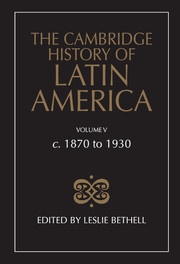Book contents
- Frontmatter
- PART ONE MEXICO
- PART TWO CENTRAL AMERICA AND THE CARIBBEAN
- PART THREE THE RIVER PLATE REPUBLICS
- PART FOUR THE ANDEAN REPUBLICSo
- PART FIVE BRAZIL
- 19 The Brazilian economy, 1870–1930
- 20 Brazil: the age of reform, 1870–1889
- 21 Brazil: the social and political structure of the First Republic, 1889–1930
- Bibliographical essays
- References
21 - Brazil: the social and political structure of the First Republic, 1889–1930
from PART FIVE - BRAZIL
Published online by Cambridge University Press: 28 March 2008
- Frontmatter
- PART ONE MEXICO
- PART TWO CENTRAL AMERICA AND THE CARIBBEAN
- PART THREE THE RIVER PLATE REPUBLICS
- PART FOUR THE ANDEAN REPUBLICSo
- PART FIVE BRAZIL
- 19 The Brazilian economy, 1870–1930
- 20 Brazil: the age of reform, 1870–1889
- 21 Brazil: the social and political structure of the First Republic, 1889–1930
- Bibliographical essays
- References
Summary
DEMOGRAPHIC AND SOCIAL CHANGE
At the time of the declaration of the Republic in 1889, Brazil was a country with a low population density, and there were vast areas in the north and the west which were virtually empty or only sparsely populated. Although these generalizations remain true for the entire period of the First Republic (1889–1930), there was nevertheless considerable demographic growth. Between 1890 and 1920 the population almost doubled, increasing from 14.3 million to 27.0 million. This was due to a process of natural growth, combined with mass European immigration in the centre-south. However, the age structure displays a feature characteristic of underdeveloped countries: a very broad base tapering sharply to a narrow peak, the result of high birth rate, coupled with high rates of general and especially infant mortality. The under twenties constituted 51 per cent and 56 per cent of the population in 1890 and 1920 respectively. The forty to fifty age group was almost three times larger than that of the over sixties in 1890, and over three times larger in 1920. The over sixties represented 4.7 per cent and 4 per cent of the population in these years. Estimates for the period between 1920 and 1940 suggest an average life expectancy of only 36-7 years; for the 1900–20 period it was even lower.
In the centre-south where immigration played a major role in population growth and in the development of social stratification, Sāo Paulo was the state which absorbed the majority of the immigrants: 51.9 per cent of the 304,054 immigrants who entered the country between 1888 and 1890, 64.9 per cent of the 1,129,315 in the period from 1891 to 1900, and 58.3 per cent of the 1,469,095 in the period from 1901 to 1920.
- Type
- Chapter
- Information
- The Cambridge History of Latin America , pp. 779 - 830Publisher: Cambridge University PressPrint publication year: 1986
References
- 12
- Cited by



